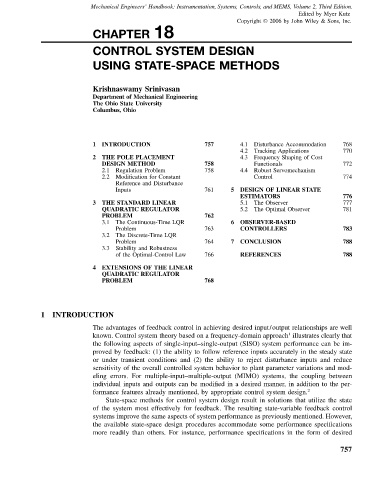Page 766 - Mechanical Engineers' Handbook (Volume 2)
P. 766
Mechanical Engineers’ Handbook: Instrumentation, Systems, Controls, and MEMS, Volume 2, Third Edition.
Edited by Myer Kutz
Copyright 2006 by John Wiley & Sons, Inc.
CHAPTER 18
CONTROL SYSTEM DESIGN
USING STATE-SPACE METHODS
Krishnaswamy Srinivasan
Department of Mechanical Engineering
The Ohio State University
Columbus, Ohio
1 INTRODUCTION 757 4.1 Disturbance Accommodation 768
4.2 Tracking Applications 770
2 THE POLE PLACEMENT 4.3 Frequency Shaping of Cost
DESIGN METHOD 758 Functionals 772
2.1 Regulation Problem 758 4.4 Robust Servomechanism
2.2 Modification for Constant Control 774
Reference and Disturbance
Inputs 761 5 DESIGN OF LINEAR STATE
ESTIMATORS 776
3 THE STANDARD LINEAR 5.1 The Observer 777
QUADRATIC REGULATOR 5.2 The Optimal Observer 781
PROBLEM 762
3.1 The Continuous-Time LQR 6 OBSERVER-BASED
Problem 763 CONTROLLERS 783
3.2 The Discrete-Time LQR
Problem 764 7 CONCLUSION 788
3.3 Stability and Robustness
of the Optimal-Control Law 766 REFERENCES 788
4 EXTENSIONS OF THE LINEAR
QUADRATIC REGULATOR
PROBLEM 768
1 INTRODUCTION
The advantages of feedback control in achieving desired input/output relationships are well
1
known. Control system theory based on a frequency-domain approach illustrates clearly that
the following aspects of single-input–single-output (SISO) system performance can be im-
proved by feedback: (1) the ability to follow reference inputs accurately in the steady state
or under transient conditions and (2) the ability to reject disturbance inputs and reduce
sensitivity of the overall controlled system behavior to plant parameter variations and mod-
eling errors. For multiple-input–multiple-output (MIMO) systems, the coupling between
individual inputs and outputs can be modified in a desired manner, in addition to the per-
formance features already mentioned, by appropriate control system design. 2
State-space methods for control system design result in solutions that utilize the state
of the system most effectively for feedback. The resulting state-variable feedback control
systems improve the same aspects of system performance as previously mentioned. However,
the available state-space design procedures accommodate some performance specifications
more readily than others. For instance, performance specifications in the form of desired
757

